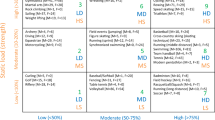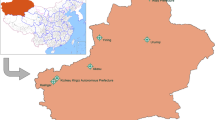Abstract
Objectve
To define if such crucial body composition parameters like body density (Db) and body surface area (BSA) could be considered in the frame of yin-yang concept, i.e., one of the most popular in conventional biomedical science theories of Chinese medicine.
Methods
Standardized Eurofit Pysical Fitness Test Battery reports of 715 junior school children have been evaluated for association of their body composition parameters with corresponding motoric fitness test results. Equations for BSA and Db calculation included height, weight, and skin-fold thickness values of the tests.
Results
Correlative analysis of major physical fitness parameters, obtained from 715 junior school children, demonstrated that participants with high BSA/Db ratio had better yang-featured anaerobic performance, whereas those with low BSA/Db ratio presented with better yin-featured aerobic performance. This result coincided with proposed suggestions to treat BSA as external yang component and Db as internal yin component of body composition. Calculated confidence intervals for BSA/Db ratio ranged between 1.073–1.15, which can be accepted as optimal for junior school children yang/yin ratio of body composition.
Conclusion
Easily accessible BSA and Db can provide specialists with useful preliminary information for generating reasonable exercise and nutritional programs.
Similar content being viewed by others
References
Segal L, Carter R, Zimmet P. The cost of obesity: the Australian perspective. Phamacoeconomics 1994;5(Suppl 1):45–52.
Wilmore GH. Body composition in sport and exercise: directions for future research. Med Sci Sports Exerc 1983;15:21–31.
Moliner-Urdiales D, Ruiz JR, Ortega FB, Jimenez-Pavon D, Vicente-Rodrigues G, Rey-Lopez JP, et al. Secular trends in health-related physical fitness in Spanish adolescents: the AVENA and HELENA studies. J Sci Med Sport 2010;13:584–588.
ACSM. ACSM's health-related physical fitness assessment manual. 1st ed. Baltimore: Lippincott Williams & Wilkins; 2005.
Paton JFR, Boscan P, Pickering AE, Nalivaiko E. The yin and yang of cardiac autonomic control: vago-sympathetic interactions revisited. Brain Res Rev 2005;49:555–565.
Chan C, Ho PS, Chow E. A body-mind-spirit model in health: an Eastern approach. Soc Work Health Care 2001;34:261–282.
Goto Y, Otani S, Grace AA. The Yin and Yang of dopamine release: a new perspective. Neuropharmacology 2007;53:583–587.
Scheid V. Tradiitonal Chinese medicine—what are we investigating? The case of menopause. Complementary Ther Med 2007;15:54–68.
Cheng-Tek Tai M. Natural or unnatural—an application of the taoist thought to bioethics. Tzu Chi Med J 2009;21:270–274.
Cheng XN. Chinese acupuncture and moxibustion (revised ed). Beijing: Foreign Language Press; 1999:12–19.
Maciocia G. The foundations of Chinese medicine. Acomprehensive text for acupuncturist & herbalists. 2nd ed. Churchill Livingstone, 2005:3–16.
Mosteller RD. Simplified calculation of body surface area. N Engl J Med 1987;317:1098.
Deurenberg P, Kusters CS, Smit HE. Assessment of body composition by bioelectrical impedance in children and young adults is srtongly age-dependent. Eur J Clin Nutr 1990;44:261–268.
Schuit AJ. Physical activity, body composition and healthy ageing. Science & Sports 2006;21:209–213.
Schwartz RS, Shuman WP, Larson V, Cain KC, Fellingham GW, Beard JC, et al. The effect of intensive endurance training on body fat distribution in young and older men. Metabolism 1991;40:545–551.
Sasai H, Katayama Y, Nakata Y, Ohkubo H, Tanaka K. Obesity phenotype and intra-abdominal fat responses to regular aerobic exercise. Diabetes Res Clin Pract 2009;84:230–238.
Simpkins J, Williams JI. Thermoregulation. In: Adanced human biology. London: Collins Educational; 1993:328–329.
Heyward VH, Wagner D. Applied body composition assessment, 2nd ed. Human Kinetics; 2004:7–10.
Hopkins ND, Stratton G, Tinken TM, McWhannell N, Ridges ND, Graves LE, et al. Relationships between measures of fitness, physical activity, body composition and vascular function in children. Atherosclerosis 2009; 204:244–249.
Bar-Or O, Rowland TW. Exercise physiology of healthy child. In: Pediatric exercise medicine. From physiologic principles to health care application. Human Kinetics 2004:12–18.
Verbraecken J, Heyning PV, Backer WD, Gaal LV. Body surface area in normal-weight, overweight and obese adults. A comparison study. Metab Clin Exp 2006;55:515–524.
Author information
Authors and Affiliations
Corresponding author
Rights and permissions
About this article
Cite this article
Shahin, A. Yin and yang of body composition assessment. Chin. J. Integr. Med. 17, 675–679 (2011). https://doi.org/10.1007/s11655-011-0844-6
Received:
Published:
Issue Date:
DOI: https://doi.org/10.1007/s11655-011-0844-6




